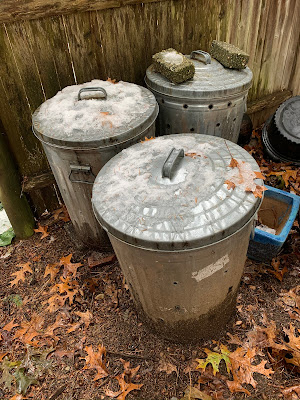Wildfires in the West, powerful hurricanes and flooding in the South, and derecho in the Midwest. Meanwhile, the Northeast has been feeling relatively safe. We’ve had a severe drought, but so far climate change hasn’t turned us into refugees.
Well, we might not be immune to strange weather events. This Friday saw an unusually early snowstorm that weighed down tree branches still in full leaf.
 |
| Ornamental plum bent low by heavy snow |
This happened once before in my memory, in 2011, when a Halloween nor’easter shut down much of the New England. But it’s still far what we expect for the end of October. We’re supposed to be raking leaves and decorating our front steps with pumpkins, not shoveling snow.
My garden got caught way off guard. All the tender perennials were still in their beds and containers. Now they’re a soggy mess, as is the basil I’d hoped to harvest.
 |
| A pot of herbs. Rosemary made it, basil didn't |
I wanted to provide blooms for pollinators through November. I don’t know whether the aster flowers will survive after two days coated with heavy snow.
 |
| Will these aster blooms last after they thaw? |
All I can do is start the process of closing down the garden for winter, though these tasks are coming a lot earlier than I’d expected. When the potting mix thaws, I’ll bag up the elephant ears and cannas and store them in the basement to repot next year.
 |
| The canna season has definitely ended |
I’d hoped to pick a few more dahlias, but their tubers too will need to be packed away if I hope to replant them in spring. Today the water barrel holds a block of ice. If the weather warms up later in the week as predicted, I’ll empty the barrel and store it in the garage.
I’m still hoping for some mild days to move compost into newly built raised beds in the vegetable garden. This will be the place for the compost in those aluminum trash barrels I used for food waste, after noticing that fruit and vegetable scraps on the open piles were attracting rodents.
 |
| Composted food waste for the raised beds |
If I can’t lift the barrels into the wheelbarrow, at least I can roll them across the yard. That’s the good thing about their cylindrical shape. I’m hoping these contained beds will boost my vegetable harvest. With 3-foot wide beds and 2-foot paths, I won’t walk on the soil around the growing plants, something I couldn’t avoid with my old free-form design.
 |
| Raised beds for vegetables |
The other activity for the next month will be relocating fallen leaves from the front of the house to the backyard. Before the snow, I’d fortunately shredded a few for the perennial bed off the deck. There I find finer mulch preferable as new young perennials emerge and gradually expand.
For the rest of the yard, I’ll be keeping the leaves whole. Lots is written these days about the advantages of this system. By letting the whole leaves lie undisturbed through the winter, we provide shelter for important native insects that hide there as adults, eggs, or pupae. Plus, it’s a lot less work than bagging or shredding those leaves.

No comments:
Post a Comment